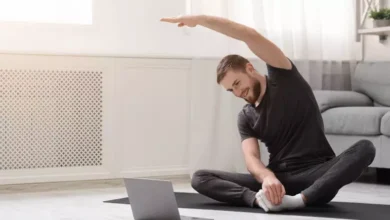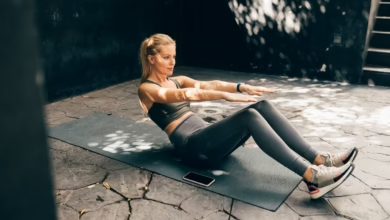Back Workout Guide: Beginner to Advanced Exercises for Real Results
Back Workout Guide: Beginner to Advanced Exercises for Real Results

A strong, well-developed back is essential not only for aesthetics but also for posture, injury prevention, and overall strength. While many people think that building back muscles requires heavy gym equipment, the truth is that you can perform an effective back workout at home with minimal or no equipment. By targeting different regions of the back—from the lats to the traps, rhomboids, and erector spinae—you can improve mobility, enhance your physique, and prevent discomfort from long hours of sitting.
This guide is designed for all fitness levels, from beginners who are just getting started to advanced athletes who want to refine their training. By the end, you will have a clear routine that promotes strength, endurance, and real results.
READ ALSO:
- Does Running Help You Lose Weight? How to Start and Progress Without Losing Your Breath
- Mika Takishima Method: 4 Transformative Exercises for Weight Loss and Healthy Aging
Follow our PAGE
Why Training Your Back Matters
The back is one of the largest and most important muscle groups in the body. It supports posture, protects the spine, and is involved in nearly every movement you perform daily, from lifting objects to simply standing tall. Neglecting back training can lead to muscle imbalances, rounded shoulders, and chronic pain.
Another key benefit of a consistent back workout at home is improved functional fitness. Strong back muscles make other exercises easier, including chest presses, squats, and even core-focused movements. A balanced workout routine not only shapes your body but also enhances athletic performance.
Beginner Back Workout at Home
If you are new to training, start with simple, low-impact exercises that build foundational strength. These moves use body weight and basic household items to stimulate your muscles.
1. Superman Hold
- Lie face down on the floor with arms extended overhead.
- Lift your arms, chest, and legs off the ground simultaneously.
- Hold for 3–5 seconds before lowering.
- Perform 3 sets of 10–12 reps.
This exercise strengthens the lower back and improves spinal stability.
2. Wall Angels
- Stand with your back against a wall, feet about 10 cm forward.
- Press your lower back gently against the wall.
- Slowly raise and lower your arms in a “snow angel” motion.
- Aim for 3 sets of 10 reps.
This improves posture and activates the upper back and shoulders.
3. Hip Hinge with Towel or Broomstick
- Place a towel or broomstick along your back, holding it against your head, upper back, and tailbone.
- Hinge at the hips, keeping your back straight.
- Return to standing position.
- Perform 3 sets of 12 reps.
This builds awareness of proper back alignment while strengthening spinal stabilizers.
Intermediate Back Training Routine
Once you feel confident with the basics, progress to dynamic exercises that add resistance and intensity.
1. Reverse Snow Angels on the Floor
- Lie face down, arms by your sides.
- Sweep your arms out and overhead, then back down.
- Keep chest slightly lifted.
- Perform 3 sets of 10–12 reps.
2. Backpack Rows
- Fill a backpack with books or bottles of water.
- Hold it with both hands, bend forward slightly, and row toward your chest.
- Complete 3 sets of 12–15 reps.
This movement mimics dumbbell rows and targets lats and rhomboids.
3. Bird-Dog
- Start on all fours.
- Extend your right arm forward and left leg backward simultaneously.
- Hold for 3 seconds, then switch sides.
- Perform 3 sets of 10 per side.
This strengthens the entire posterior chain and enhances balance.
4. Reverse Plank
- Sit on the floor, legs extended, hands behind your hips.
- Lift your body so only heels and hands touch the floor.
- Hold for 20–40 seconds.
- Repeat 3 times.
This works the posterior shoulders, traps, and lower back.
Advanced Back Workout for Real Gains
For experienced individuals, these exercises demand greater control, resistance, and stamina. They mimic gym-level intensity while still being achievable at home.
1. Pike Push-Ups
- Start in a downward dog position.
- Bend your elbows to lower your head toward the floor.
- Push back up.
- Perform 3 sets of 8–12 reps.
Though targeting shoulders, this move also engages the traps and upper back.
2. Towel Lat Pulls (with Door Frame)
- Hold a towel draped over a sturdy door frame.
- Lean back slightly and pull yourself toward the door, engaging your lats.
- Perform 3 sets of 10–12 reps.
3. Elevated Reverse Flies
- Lie face down on a bench or bed with arms hanging.
- Hold water bottles or small weights.
- Raise arms out to the sides, squeezing shoulder blades.
- Perform 3 sets of 12 reps.
4. Archer Push-Ups
- Begin in a push-up position.
- Shift weight to one arm while the other extends to the side.
- Alternate sides.
- Perform 3 sets of 8–10 reps.
These moves demand strength, coordination, and endurance, making them perfect for those ready to push their limits.
How to Structure Your Back Workout at Home
For best results, organize your training into progressive levels:
- Beginners: Train 2–3 times a week, 20–25 minutes per session.
- Intermediate: Train 3–4 times a week, 30–40 minutes per session.
- Advanced: Train 4–5 times a week, 40–50 minutes per session with intensity.
Warm up with light cardio or dynamic stretching before each workout, and finish with static stretches focusing on the spine and shoulders.
Extra Tips for Back Training Success
- Consistency is key: Results come from regular training, not sporadic effort.
- Nutrition matters: A balanced diet rich in protein, healthy fats, and complex carbs supports muscle growth and recovery.
- Posture awareness: Practice sitting and standing tall throughout the day to reinforce training effects.
- Progressive overload: Gradually increase reps, sets, or resistance to continue challenging your muscles.
Conclusion
Building a stronger, healthier back is possible without stepping into a gym. From simple beginner-friendly holds to advanced resistance-based movements, a structured back workout at home can deliver impressive results. Whether your goal is improved posture, reduced pain, or enhanced aesthetics, consistency and dedication are your best tools.
With the right plan and mindset, your back can become one of your strongest assets, supporting your fitness journey and daily life.

Hello! My name is Alan Teixeira and I am passionate about helping people live healthier, more balanced lives. From mindful eating to daily habits that promote physical and mental well-being, I believe that small, consistent changes can lead to powerful transformations.
I created this blog to share practical tips, reliable information, and thoughtful insights that can inspire you to take better care of yourself—with balance, mindfulness, and positivity.
If you are looking to improve your health, nourish your body, and build a lighter, more fulfilling routine, you are in the right place. Welcome!





